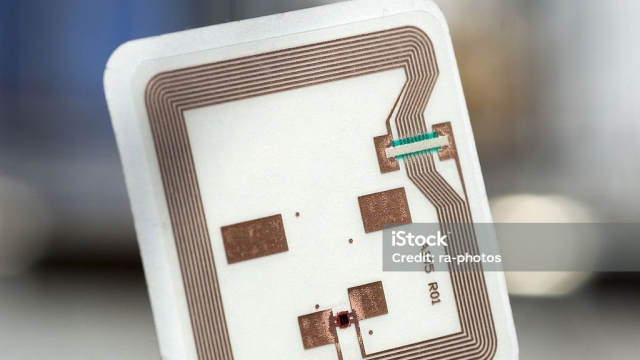The Future Unfolds: Exploring the Power of RFID Technology
As we step into the future, the boundaries of what technology can achieve continue to expand. One such innovation that promises to revolutionize various industries is RFID technology. RFID, short for Radio Frequency Identification, is a wireless technology that allows for the identification and tracking of objects or individuals using radio waves. With its ability to provide seamless and real-time data collection, RFID has the potential to streamline processes, enhance efficiency, and unlock new opportunities across sectors ranging from logistics and supply chain management to healthcare and retail.
At its core, RFID technology consists of three essential components: a tag, a reader, and a backend system. The tag, which can be as small as a grain of rice or embedded within a label or card, contains an electronic chip and an antenna. When activated by the radio signal emitted by the reader, the tag transmits its unique identifier, enabling the reader to capture and store the data. This information is then processed and analyzed by the backend system, which can be integrated with existing software or databases to provide valuable insights and actionable information.
One of the key advantages of RFID technology lies in its ability to facilitate automated and accurate identification and tracking. Unlike traditional barcodes or QR codes, which require line-of-sight scanning, RFID tags can be read from a distance, even in challenging environments. This means that items can be quickly and efficiently identified, counted, and located without the need for physical contact, which is particularly beneficial in scenarios where speed and accuracy are crucial.
Moreover, RFID technology also enables real-time monitoring and visibility throughout the supply chain. By tagging goods, assets, or even individuals, companies can gain valuable insights into the movement, status, and condition of their assets at any given time. This not only improves operational efficiency but also allows for better inventory management, reduced losses, and enhanced customer satisfaction.
In the realm of healthcare, RFID has the potential to revolutionize patient care and safety. By tagging medical equipment, drugs, and patients themselves, healthcare professionals can ensure accurate and timely administration of treatments, monitor the whereabouts of critical assets, and reduce the risk of errors or misplaced items. Furthermore, the ability to track and trace the utilization of medical supplies can significantly improve inventory management, helping healthcare organizations reduce waste, control costs, and optimize resources.
As we delve deeper into the possibilities offered by RFID technology, the future unfolds with countless opportunities to transform industries and enhance our daily lives. With its ability to automate processes, improve visibility, and enable seamless connectivity, RFID holds the potential to reshape the way we operate across various sectors. Whether it’s optimizing supply chains, enhancing patient care, or revolutionizing retail experiences, the power of RFID technology is set to unlock a new era of innovation, efficiency, and limitless potential.
1. The Basics of RFID Technology
RFID technology, short for Radio Frequency Identification technology, is a revolutionary system that allows for easy and efficient tracking of objects or individuals using radio waves. It has gained significant popularity and is now being employed in various industries for inventory management, supply chain optimization, access control, and much more.
At its core, RFID technology consists of three main components: RFID tags, RFID readers, and backend systems. RFID tags are small, electronic devices that contain a unique identification number along with other relevant data. These tags can be attached or embedded within objects, such as products or ID cards.
When an RFID tag comes within range of an RFID reader, the reader emits radio waves that power the tag and activate it. Once activated, the tag transmits its identification information back to the reader, enabling it to capture data about the tagged object or individual. This communication happens wirelessly and without the need for direct line-of-sight.
The captured data is then processed by backend systems, which can provide real-time visibility and analysis. This valuable information allows businesses to make informed decisions regarding inventory management, delivery logistics, and customer engagement.
With the ability to track and identify items with remarkable accuracy and efficiency, RFID technology offers immense potential for enhancing operational processes across industries. In the next section, we will delve deeper into the various applications and benefits of RFID technology. Stay tuned!
2. [Section 2 Title: TBD]
[Content for section 2]
3. [Section 3 Title: TBD]
[Content for section 3]
2. Applications and Benefits of RFID
RFID technology has revolutionized several industries with its wide range of applications and numerous benefits. This article explores the power of RFID technology in various sectors, highlighting its potential to streamline processes and enhance efficiency.
-
Inventory Management: RFID technology allows for seamless inventory tracking, making it an invaluable tool for businesses. With RFID tags attached to products or packaging, companies can easily monitor stock levels, track movement, and automate replenishment processes. This not only helps keep accurate inventory records but also reduces errors, minimizes manual labor, and improves overall supply chain management.
-
Access Control and Security: RFID technology is widely used for access control systems in various settings such as offices, hospitals, and residential complexes. By using RFID-enabled cards or badges, authorized personnel can gain entry to secure areas, enhancing security measures and ensuring only authorized individuals have access. The technology also enables efficient monitoring and logging of entry and exit data for effective security management.
-
Asset Tracking: RFID technology offers a reliable solution for asset tracking, allowing organizations to easily locate and manage valuable assets. Whether it’s tracking equipment in a hospital, managing fleet vehicles, or monitoring the movement of high-value merchandise, RFID tags provide real-time visibility and enable efficient asset utilization. This helps reduce losses, improve asset maintenance, and optimize resource allocation.
RFID technology is versatile, scalable, and has the potential to transform various industries. By harnessing the power of RFID, businesses can streamline operations, improve accuracy, and gain valuable insights into their processes. As technology continues to advance, the future of RFID holds even greater potential for innovation and efficiency.
3. Challenges and Future Possibilities of RFID
RFID technology, while promising, also presents several challenges that need to be addressed for its full potential to be realized. One key challenge is privacy and security concerns. As RFID tags can transmit information wirelessly, there is a risk of unauthorized access or tracking. Protecting personal data and ensuring secure communication channels will be of utmost importance to gain public trust and wider adoption of RFID technology.
Another challenge is the limited read range of RFID tags. Currently, most RFID systems have a range of a few meters, which may not be sufficient for certain applications like inventory management in large warehouses or real-time asset tracking. Efforts are being made to extend the read range of RFID technology, either through advancements in tag design or by developing new reader antennas that can capture signals from greater distances.
Furthermore, the cost of implementing RFID systems has been a barrier for many organizations. While the prices of RFID tags and readers have decreased over the years, they still pose a significant investment, particularly for small businesses. Finding cost-effective solutions and making RFID technology more accessible will be crucial to its widespread adoption in various industries.
Despite these challenges, the future possibilities of RFID technology are vast. RFID has the potential to revolutionize supply chain management by enabling real-time tracking and improving inventory control. It can enhance asset management, automate processes, and optimize logistics operations. Additionally, in healthcare, RFID technology can improve patient safety by ensuring accurate medication administration and tracking medical equipment.
In conclusion, RFID technology holds great promise, but it also faces challenges such as privacy concerns, limited read range, and cost. However, as these challenges are addressed, the future of RFID looks bright, with possibilities spanning across industries, from retail and manufacturing to healthcare and beyond.





